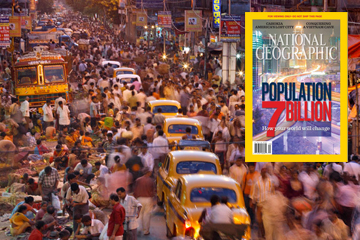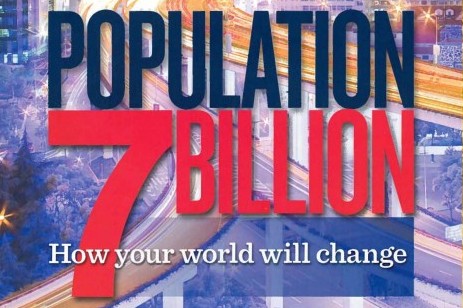 Sometime in the latter half of this year, the world population will hit a new milestone: 7 billion people. Already? Didn’t we just hit 6 billion? Yep, a mere dozen years ago — and that’s probably the last time you heard much about population. It takes a big, round number with lots of zeroes to get MSM attention.
Sometime in the latter half of this year, the world population will hit a new milestone: 7 billion people. Already? Didn’t we just hit 6 billion? Yep, a mere dozen years ago — and that’s probably the last time you heard much about population. It takes a big, round number with lots of zeroes to get MSM attention.
So in 2011, expect to hear the P word a lot more than you did in 2010, and a lot more than you will in 2012. National Geographic is kicking off the action with a cover story and photo essay.
It’s projected to take us slightly longer to get to the next big, round number with lots of zeroes — 14 years instead of 12. While the total number of people on the planet is still growing fast, the nature and speed of that growth has been changing dramatically. This Economist video gives you great visual overview of the trends. (Is it just me or does that graphic look like a packet of birth-control pills?)
Even as we’re adding people, we’re also dramatically changing the demographic composition of entire societies, and creating different kinds of problems along the way — like the challenge of aging populations in many developed countries. Bryan Walsh of Time suggests that immigration could be one solution:
[H]ere’s the planet we could have in 2050: an overpopulated, overstressed developing world and an aging, economically stagnant developed world, with inequality even larger than it is today. Is there any way to escape that fate? While development and education will be incredibly important (especially for women — literacy is one of the best ways to reduce fertility), the answer may end up being immigration. Think about it — in the future the developed world will lack young workers, and the developing world will have an excess of that resource. Immigration could be a way to balance demographics and economics — alleviating population pressure in the poorer parts of the world while jump starting aging developed nations. The U.S. already does this — immigration will provide most of American population growth. It would be a radical solution, given the political resistance to increased immigration in much of the rich world. (If you think it’s a hot topic in the U.S., try Japan, which steadfastly resists assimilating foreigners, despite the dire threat posed by an aging population.) But it might be the only way to save our overpopulated planet.
So much juicy stuff to talk about this year.
UPDATE: I had included here a big graphic about population growth, but a reader pointed out that at least some of the info in the graphic was incorrect, so I’ve removed it. Here instead is a National Geographic video that accompanies the magazine’s cover story on population:

